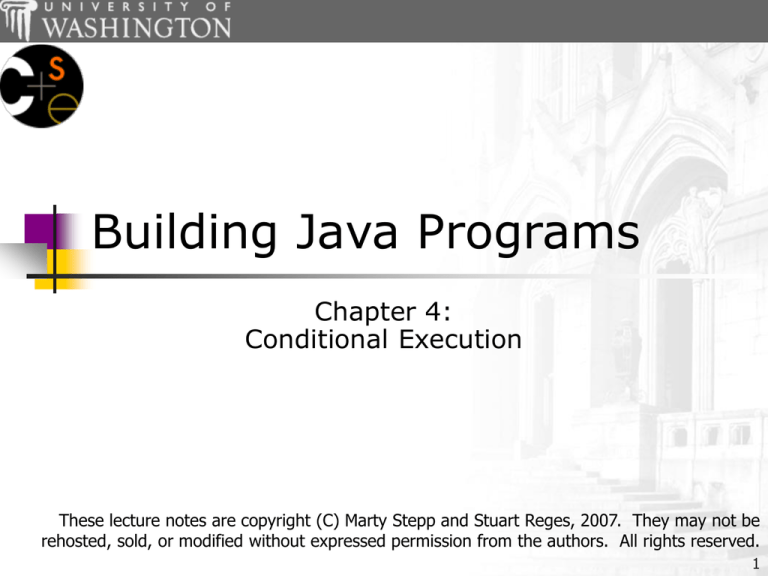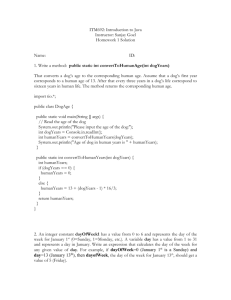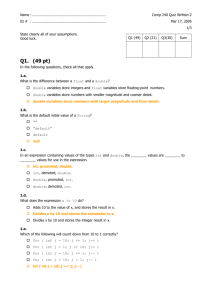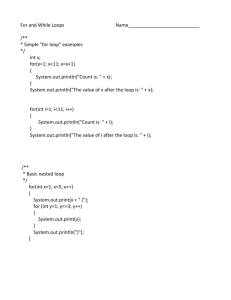
Building Java Programs
Chapter 4:
Conditional Execution
These lecture notes are copyright (C) Marty Stepp and Stuart Reges, 2007. They may not be
rehosted, sold, or modified without expressed permission from the authors. All rights reserved.
1
Lecture outline
Lecture 9
conditional execution
the if statement and the if/else statement
relational expressions
nested if/else statements
Lecture 10
subtleties of conditional execution
factoring if/else code
fencepost loops
methods with conditional execution
revisiting return values
2
if/else statements
suggested reading: 4.2
3
The if statement
if statement: A Java statement that executes a block
of statements only if a certain condition is true.
If the condition is not true, the block of statements is skipped.
General syntax:
if (<condition>) {
<statement> ;
<statement> ;
...
<statement> ;
}
Example:
double gpa = console.nextDouble();
if (gpa >= 2.0) {
System.out.println("Your application is accepted.");
}
4
if statement flow diagram
5
The if/else statement
if/else statement: A Java statement that executes
one block of statements if a certain condition is true,
and a second block of statements if it is false.
General syntax:
if (<condition>) {
<statement(s)> ;
} else {
<statement(s)> ;
}
Example:
double gpa = console.nextDouble();
if (gpa >= 2.0) {
System.out.println("Welcome to Mars University!");
} else {
System.out.println("Your application is denied.");
}
6
if/else flow diagram
7
Relational expressions
The <condition> used in an if or if/else statement is
the same kind seen in a for loop.
for (int i = 1; i <= 10; i++) {
The conditions are actually of type boolean, seen in Ch. 5.
These conditions are called relational expressions
and use one of the following six relational operators:
Operator
Meaning
Example
Value
==
equals
1 + 1 == 2
true
!=
does not equal
3.2 != 2.5
true
<
less than
10 < 5
false
>
greater than
10 > 5
true
<=
less than or equal to
126 <= 100
false
>=
greater than or equal to 5.0 >= 5.0
true
8
Evaluating rel. expressions
Relational operators have lower precedence than math operators.
Example:
5 * 7 >=
5 * 7 >=
35
>=
35
>=
true
3 + 5 * (7 - 1)
3 + 5 * 6
3 + 30
33
Relational operators cannot be "chained" as they can in algebra.
Example:
2 <= x <= 10
true
<= 10
error!
9
if/else question
Write code to read a number from the user and print
whether it is even or odd using an if/else statement.
Example executions:
Type a number: 42
Your number is even
Type a number: 17
Your number is odd
10
Loops with if/else
Loops can be used with if/else statements:
int nonnegatives = 0, negatives = 0;
for (int i = 1; i <= 10; i++) {
int next = console.nextInt();
if (next >= 0) {
nonnegatives++;
} else {
negatives++;
}
}
public static void printEvenOdd(int max) {
for (int i = 1; i <= max; i++) {
if (i % 2 == 0) {
System.out.println(i + " is even");
} else {
System.out.println(i + " is odd");
}
}
}
11
Nested if/else statements
Nested if/else statement: A chain of if/else that can select
between many different outcomes based on several conditions.
General syntax:
if (<condition>) {
<statement(s)> ;
} else if (<condition>) {
<statement(s)> ;
} else {
<statement(s)> ;
}
Example:
if (number > 0) {
System.out.println("Positive");
} else if (number < 0) {
System.out.println("Negative");
} else {
System.out.println("Zero");
}
12
Nested if/else variations
A nested if/else can end with an if or an else.
If it ends with else, one of the code paths must be taken.
If it ends with if, the program might not execute any path.
Example ending with else:
if (place == 1) {
System.out.println("You win the gold medal!");
} else if (place == 2) {
System.out.println("You win a silver medal!");
} else if (place == 3) {
System.out.println("You earned a bronze medal.");
}
Are there any cases where this code will not print a message?
How could we modify it to print a message to non-medalists?
13
Nested if/else flow diagram
if (<condition>) {
<statement(s)> ;
} else if (<condition>) {
<statement(s)> ;
} else {
<statement(s)> ;
}
14
Nested if/else/if flow diagram
if (<condition>) {
<statement(s)> ;
} else if (<condition>) {
<statement(s)> ;
} else if (<condition>) {
<statement(s)> ;
}
15
Sequential if flow
if (<condition>) {
<statement(s)> ;
}
if (<condition>) {
<statement(s)> ;
}
if (<condition>) {
<statement(s)> ;
}
16
Structures of if/else code
Choose 1 of many paths:
(conditions are mutually exclusive)
if (<condition>) {
<statement(s)>;
} else if (<condition>) {
<statement(s)>;
} else {
<statement(s)>;
}
Choose 0 or 1 of many paths:
(conditions are mutually exclusive and
any action is optional)
if (<condition>) {
<statement(s)>;
} else if (<condition>) {
<statement(s)>;
} else if (<condition>) {
<statement(s)>;
}
Choose 0, 1, or many of many paths:
(conditions/actions are independent of each other)
if (<condition>) {
<statement(s)>;
}
if (<condition>) {
<statement(s)>;
}
if (<condition>) {
<statement(s)>;
}
17
Which nested if/else to use?
Which if/else construct is most appropriate to perform
each of the following tasks?
Reading the user's GPA and printing whether the student is on
the dean's list (3.8 to 4.0) or honor roll (3.5 to 3.8).
Printing whether a number is even or odd.
Printing whether a user is lower-class, middle-class, or upperclass based on their income.
Reading a number from the user and printing whether it is
divisible by 2, 3, and/or 5.
Printing a user's grade of A, B, C, D, or F based on their
percentage in the course.
18
Which nested if/else to use?
Which if/else construct is most appropriate to perform
each of the following tasks?
Reading the user's GPA and printing whether the student is on
the dean's list (3.8 to 4.0) or honor roll (3.5 to 3.8).
Printing whether a number is even or odd.
nested if / else if / else
Reading a number from the user and printing whether it is
divisible by 2, 3, and/or 5.
simple if / else
Printing whether a user is lower-class, middle-class, or upperclass based on their income.
nested if / else if
sequential if / if / if
Printing a user's grade of A, B, C, D, or F based on their
percentage in the course.
nested if / else if / else if / else if / else
19
How to comment: if/else
Comments on an if statement don't need to describe exactly what
the if statement is testing.
Instead, they should describe why you are performing that test,
and/or what you intend to do based on its result.
Bad example:
// Test whether student 1's GPA is better than student 2's
if (gpa1 > gpa2) {
// print that student 1 had the greater GPA
System.out.println("The first student had the greater GPA.");
} else if (gpa2 > gpa1) {
// print that student 2 had the greater GPA
System.out.println("The second student's GPA was higher.");
} else { // there was a tie
System.out.println("There has been a tie!");
}
Better example:
// Print a message about which student had the higher grade point average.
if (gpa1 > gpa2) {
System.out.println("The first student had the greater GPA.");
} else if (gpa2 > gpa1) {
System.out.println("The second student's GPA was higher.");
} else { // gpa1 == gpa2 (a tie)
System.out.println("There has been a tie!");
20
}
How to comment: if/else 2
If an if statement's test is straightforward, and if the
actions to be taken in the bodies of the if/else
statement are very different, sometimes putting
comments on the bodies themselves is more helpful.
Example:
if (guessAgain == 1) {
// user wants to guess again; reset game state and
// play another game
System.out.println("Playing another game.");
score = 0;
resetGame();
play();
} else {
// user is finished playing; print their best score
System.out.println("Thank you for playing.");
System.out.println("Your score was " + score);
}
21
Math.max/min vs. if/else
Many if/else statements that choose the larger or
smaller of 2 numbers can be replaced by a call to
Math.max or Math.min.
int z;
// z should be larger of x, y
if (x > y) {
z = x;
} else {
z = y;
}
int z = Math.max(x, y);
double d =
if (b < d)
d = b;
}
if (c < d)
d = c;
}
double d =
a;
{
// d should be smallest of a, b, c
{
Math.min(a, Math.min(b, c));
22
Lecture outline
Lecture 9
conditional execution
the if statement and the if/else statement
relational expressions
nested if/else statements
Lecture 10
subtleties of conditional execution
factoring if/else code
fencepost loops
methods with conditional execution
revisiting return values
23
Subtleties of conditional
execution
suggested reading: 4.3
24
Factoring if/else code
factoring: extracting common/redundant code
Factoring if/else code reduces the size of the if and else
statements and can sometimes eliminate the need for if/else
altogether.
Example:
int x;
if (a == 1) {
x = 3;
} else if (a == 2) {
x = 5;
} else { // a == 3
x = 7;
}
int x = 2 * a + 1;
25
Code in need of factoring
The following example has a lot of redundant code in the if/else:
if (money < 500) {
System.out.println("You have, $" + money + " left.");
System.out.print("Caution! Bet carefully.");
System.out.print("How much do you want to bet? ");
bet = console.nextInt();
} else if (money < 1000) {
System.out.println("You have, $" + money + " left.");
System.out.print("Consider betting moderately.");
System.out.print("How much do you want to bet? ");
bet = console.nextInt();
} else {
System.out.println("You have, $" + money + " left.");
System.out.print("You may bet liberally.");
System.out.print("How much do you want to bet? ");
bet = console.nextInt();
}
26
Code after factoring
Factoring tips:
If the start of each branch is the same, move it before the if/else.
If the end of each branch is the same, move it after the if/else.
System.out.println("You have, $" + money + " left.");
if (money < 500) {
System.out.print("Caution! Bet carefully.");
} else if (money < 1000) {
System.out.print("Consider betting moderately.");
} else {
System.out.print("You may bet liberally.");
}
System.out.print("How much do you want to bet? ");
bet = console.nextInt();
27
Fencepost loops
suggested reading: 4.1
28
The fencepost problem
Problem: Write a static method named printNumbers
that prints each number from 1 to a given maximum,
separated by commas.
For example, the method call:
printNumbers(5)
should print:
1, 2, 3, 4, 5
Let's write a solution to this problem...
29
Flawed solution 1
A flawed solution:
public static void printNumbers(int max) {
for (int i = 1; i <= max; i++) {
System.out.print(i + ", ");
}
System.out.println(); // to end the line of output
}
Output from printNumbers(5):
1, 2, 3, 4, 5,
30
Flawed solution 2
Another flawed solution:
public static void printNumbers(int max) {
for (int i = 1; i <= max; i++) {
System.out.print(", " + i);
}
System.out.println(); // to end the line of output
}
Output from printNumbers(5):
, 1, 2, 3, 4, 5
31
Fence post analogy
We print n numbers but need only n - 1 commas.
This problem is similar to the task of building a fence
with lengths of wire separated by posts.
often called a fencepost problem
If we repeatedly place a post and wire, the last post has an
extra dangling wire.
A flawed algorithm:
for (length of fence):
place some post.
place some wire.
32
Fencepost loop
The solution is to add an extra statement outside the
loop that places the inital "post."
This is sometimes also called a fencepost loop or a
"loop-and-a-half" solution.
The revised algorithm:
place a post.
for (length of fence - 1):
place some wire.
place some post.
33
Fencepost method solution
A version of printNumbers that works:
public static void printNumbers(int max) {
System.out.print(1);
for (int i = 2; i <= max; i++) {
System.out.print(", " + i);
}
System.out.println(); // to end the line of output
}
OUTPUT from printNumbers(5):
1, 2, 3, 4, 5
34
Fencepost practice problem
Write a method named printFactors that, when given
a number, prints its factors in the following format
(using an example of 24 for the parameter value):
[1, 2, 3, 4, 6, 8, 12, 24]
35
Fencepost practice problem
Write a Java program that reads a base and a
maximum power and prints all of the powers of the
given base up to that max, separated by commas.
Base: 2
Max exponent: 9
The first 9 powers of 2 are:
2, 4, 8, 16, 32, 64, 128, 256, 512
36
Methods with if/else
suggested reading: 4.5
37
if/else with return
Methods can be written to return different values under
different conditions using if/else statements:
public static int min(int a, int b) {
if (a > b) {
return a;
} else {
return b;
}
}
An example that maps chess board squares to colors:
public static Color chessBoardColor(int row, int column) {
if ((row + column) % 2 == 0) {
return Color.WHITE;
} else {
return Color.BLACK;
}
}
38
More examples
Another example that returns the first word in a string:
public static String firstWord(String s) {
int index = s.indexOf(" ");
if (index >= 0) {
return s.substring(0, index);
} else {
// only one word in String
return s;
}
}
It is an error not to return a value in every path:
public static int min(int a, int b) {
if (a > b) {
return b;
}
// Error; not all code paths return a value.
// What if a <= b ?
}
39
All code paths must return
The following code does not compile:
public static int min(int a, int b) {
if (a >= b) {
return b;
} else if (a < b) {
return a;
}
}
It produces the "Not all paths return a value" error.
To our eyes, it is clear that all paths (greater, equal, less) do
return a value.
But the compiler thinks that if/else/if code might choose not
to execute any branch, so it refuses to accept this code.
How can we fix it?
40
for loops with if/else return
Methods with loops that return values must consider
the case where the loop does not execute the return.
public static int indexOf(String s, char c) {
for (int i = 0; i < s.length(); i++) {
if (s.charAt(i) == c) {
return i;
}
}
// error; what if c does not occur in s?
}
A better version that returns -1 when c is not found:
public static int indexOf(String s, char c) {
for (int i = 0; i < s.length(); i++) {
if (s.charAt(i) == c) {
return i;
}
}
return -1;
// not found
}
41
if/else return question
Write a method named numUnique that accepts two
integers as parameters and returns how many unique
values were passed.
Write a method named countFactors that returns the
number of factors of an integer.
For example, numUnique(3, 7) returns 2 because 3 and 7 are
two unique numbers, but numUnique(4, 4) returns 1 because
4 and 4 only represent one unique number.
For example, countFactors(60) returns 11 because 1, 2, 3, 4,
5, 6, 10, 15, 20, 30, and 60 are factors of 60.
Modify the pigLatinWord and encode/decode methods
seen previously so that they return their results rather
than printing them.
42
Method return question
Write a program that prompts the user for a maximum
integer and prints out a list of all prime numbers up to
that maximum. Here is an example log of execution:
Maximum number? 50
2, 3, 5, 7, 11, 13, 17, 19, 23, 29, 31, 37, 41, 43, 47
14 total primes
43






